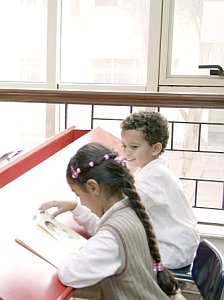Teaching ESL students alongside mother-tongue speakers in an international school environment presents numerous challenges, not least to the students. It’s hard even to start to highlight the challenges to international school teachers of teaching ESL students in such a short article, but here are a few key areas to consider.
Include learners of all cultures into the classroom environment and the school
 It’s not easy to adjust to the conventions of another culture. Being in a new environment can mean feeling like a permanent stranger in an unfamiliar place. It’s possible for a child new to English suddenly to feel unsuccessful at almost every task. This can result in feelings of inadequacy and frustration. The customs in which they grew up may no longer have significance and new, unfamiliar customs unexpectedly have priority. More advanced learners usually already have a good understanding of culture. It is important, however, not to assume this and to include the home culture of the ESL learner.
It’s not easy to adjust to the conventions of another culture. Being in a new environment can mean feeling like a permanent stranger in an unfamiliar place. It’s possible for a child new to English suddenly to feel unsuccessful at almost every task. This can result in feelings of inadequacy and frustration. The customs in which they grew up may no longer have significance and new, unfamiliar customs unexpectedly have priority. More advanced learners usually already have a good understanding of culture. It is important, however, not to assume this and to include the home culture of the ESL learner.
Assess their needs alongside the needs of more advanced fluent speakers
Assessment in English speaking schools is often geared towards more advanced learners. It’s important to consider what is appropriate for learners who are less advanced in English.
Understand the challenge of learning a new writing system
A new writing system can prove an additional challenge to the ESL learner. Some new arrivals appear to cope well with a new writing system, especially if their home language has many similarities but, without training, issues can occur with children acquiring a patchy understanding of direction, letter formation, phonological processing, lexical processing, orthographical regularities, punctuation, creativity and functions. These 8 elements, in no particular order, are based on Cook’s (p426-430, 2005) outline of how one might learn to use a second language writing system.
Cater for all the learners in the class, whatever their level of English
It is easy to set objectives too high for the English language learners. Remember that every child should be successful from the most advance at English to those in the beginning stages.
Provide support in the use of effective language learning strategies
It is important to consider the tools that a child can use to help them learn a language. It’s our role as teachers to provide guidance in how to learn English.

Ensure resources are supportive for ESL learners
There is a wealth of resources available to support learners of ESL. This can include authentic resources: tickets, magazines, photos, newspapers, menus, tourist brochures, personal documents e.g. passport, school reports, tapes with songs and stories, poems, posters, catalogues, postcards, story props, dual language texts, big books, magnetic letters, word games, puppets, objects, published language games, homemade games, simple worksheets, story sequencing cards and story packs – to name just a few! Make sure resources are easy to use, appropriate and functional.



